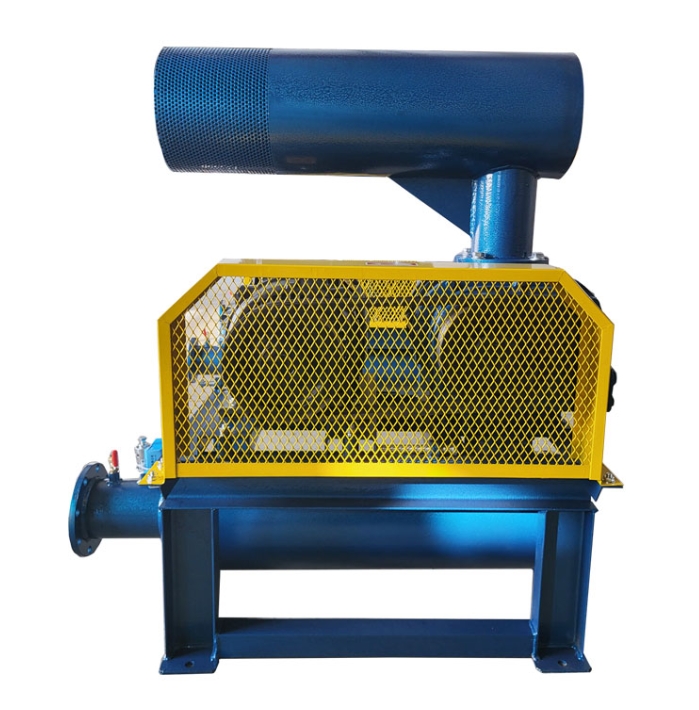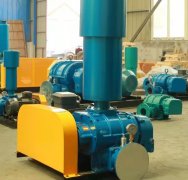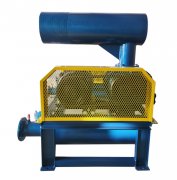There are significant differences in the working principle, performance characteristics, and application scenarios between Roots fans and ordinary fans such as centrifugal fans and axial fans. The following are the main differences between the two:
---

**1. Different working principles**
|* * Comparison item * * | * Roots blower * * | * * Ordinary blower (taking centrifugal blower as an example) * *|
|------------------|-------------------------------|-------------------------------|
|* * Working principle * * | * * Volumetric * * (positive displacement principle)<br>By rotating two meshing rotors, gas is mechanically squeezed and forcibly transported** Kinetic energy type (centrifugal force principle) accelerates gas through a high-speed rotating impeller, converting kinetic energy into static pressure|
|Gas compression method * * | No internal compression, pressure is determined by system resistance< Br>(Constant flow rate, pressure changes with resistance) | By doing work on the gas through the impeller, pressure is increased< Br>(Flow and pressure vary with speed)|
|* * Structural Features * * | Clearance between rotor and casing (0.1~0.4mm), synchronous gear transmission, non-contact| The gap between the impeller and the volute is relatively large< Gas flow depends on the shape and speed of the impeller|
---
**2. Performance Characteristics Comparison**
|* * Comparison item * * | * Roots blower * * | * * Ordinary blower (centrifugal/axial flow) * *|
|------------------|-------------------------------|-------------------------------|
|* * Flow and pressure * * | * * Flow stability * *, proportional to speed< The pressure range is relatively wide (0~100kPa), but it is limited by the structure** Dynamic changes in flow and pressure * *< Centrifugal fan medium pressure (<50kPa), axial flow fan low pressure (<10kPa)|
|Efficiency * * | The efficiency is lower at medium and low pressures (60-70), and energy consumption significantly increases at high pressures| High efficiency (70-85), especially suitable for high flow conditions|
|* * Noise * * | Large (requires muffler)< Due to periodic exhaust shock of the rotor| Relatively small (centrifugal fan noise lower than Roots)|
|* * Maintenance complexity * * | The structure is simple, but the gears and bearings require regular lubrication| Easy maintenance (gearless transmission)|
---
**3. Differences in applicable scenarios**
|* * Scenario * * | * Roots blower * * | * * Regular blower * *|
|------------------|-------------------------------|-------------------------------|
|* * Sewage treatment * * | Aeration oxygen supply (requires stable flow rate)| Ventilation and air exchange (centrifugal fan)|
|* * Pneumatic Conveying * * | Conveying granular materials (such as cement, grains)| Not suitable (due to insufficient pressure)|
|* * Vacuum application * * | Can be used as a low vacuum pump (requires a front-end pump)| Cannot be used for vacuum|
|* * Industrial ventilation * * | Not applicable (high energy consumption)| Widely used for workshop ventilation (axial flow fan)|
|High temperature gas requires special materials (such as stainless steel)| Centrifugal fans can withstand medium temperatures|
---
**4. Summary of Key Differences**
1. * * Flow control**
-Roots blower: * * Constant flow rate * *, suitable for scenarios where air volume needs to be controlled (such as aeration).
-Ordinary fan: flow rate varies with pressure, suitable for variable working conditions (such as ventilation).
2. * * Pressure generation**
-Roots blower: Pressure is determined by system resistance, and overpressure can easily lead to overload.
-Centrifugal fan: The pressure is determined by the impeller speed and structure, and the flow rate automatically decreases when overpressure occurs.
3. * * Energy consumption difference**
-Roots blower has low efficiency and high energy consumption under high-pressure conditions; Centrifugal fans are more energy-efficient at high flow rates and medium pressures.
4. * * Noise and vibration**
-The Roots blower produces loud noise and requires sound insulation measures; Centrifugal fans run more smoothly.
---
**5. Selection suggestions**
-* * Choose Roots blower * *:
-Stable flow rate and medium low pressure conveying (such as sewage treatment and pneumatic conveying) are required.
-The gas contains a small amount of dust or humidity (with strong structural tolerance).
-* * Choose a regular fan * *:
-High flow ventilation and cooling (such as factories and tunnels).
-Scenarios that are sensitive to noise or require high energy efficiency.
---
**Additional note: Difference from axial flow fan**
-Axial flow fan: Gas flows along the axial direction, with a large air volume and pressure (<1kPa), commonly used for cooling or exhaust (such as electric fans and cooling towers).
-Roots blower: Gas flows perpendicular to the axial direction, with higher pressure, suitable for pipeline transportation.
---
**Summary**
The core advantage of Roots blower is fixed flow conveying, while ordinary blowers (centrifugal/axial) are more suitable for variable flow and low resistance scenarios. When making a selection, it is necessary to conduct a comprehensive evaluation based on * * pressure requirements, gas characteristics, and energy consumption costs * *.



